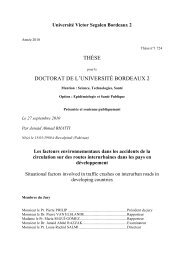Télécharger le texte intégral
Télécharger le texte intégral
Télécharger le texte intégral
Create successful ePaper yourself
Turn your PDF publications into a flip-book with our unique Google optimized e-Paper software.
4 MILLET ET AL.Downloaded By: [Mil<strong>le</strong>t, Xavier] At: 10:57 4 November 2009Differences between fixed- and random-effects modelsreside in the calculation of CIs, resulting in a wider rangeof values in the random-effects model. Therefore, therandom-effects model is a more conservative statisticalmodel, and for this reason we have to introduce anappropriate degree of statistical caution when the poo<strong>le</strong>deffect sizes estimated are not significant.Main results of the analyses are illustrated graphicallyin a forest plot. Forest plots show the estimated primingand 95% CIs globally and for each study. When the CIof the effect size does not cross zero, it can be concludedthat it significantly differs from zero, and thus that primingperformances are significantly different betweengroups.A potential threat to the validity of a meta-analysis isthe publication bias arising from the tendency forresearchers and editors to favor experimental results thatare positive, which are more likely to be accepted forpublication than research results that remain inconclusive(Dickersin, 1990). In this case, publication bias may<strong>le</strong>ad to overestimation of the magnitude of the effect sizein the population. We determined whether the publishedliterature represents a biased samp<strong>le</strong> of the studies bytesting for asymmetry with the Egger weighted regressiontest (Egger, Smith, Schneider, & Minder, 1997)where the intercept is zero if no bias is present. Egger’sregression test detects publication bias by determiningwhether the intercept deviates significantly in a regressionof standardized effect estimates against their precision.We performed a sensitivity analysis to determinethe robustness of our results. To determine whether theresults of the meta-analysis were disproportionatelyinfluenced by a particular study, we recomputed thepoo<strong>le</strong>d effect size after de<strong>le</strong>ting each study one at a time.Three sets of analyses were carried out. First, wecalculated the effect size in the AD group betweenstudied and unstudied words rates of comp<strong>le</strong>tion todetermine whether the patients exhibit a significantpriming effect (within-group comparison in the ADpatients group only). Second, we calculated the effectsize between AD patients and elderly controls’ primingscores (studied words minus unstudied words rates ofcomp<strong>le</strong>tion) to determine whether overall word-stempriming magnitude was equiva<strong>le</strong>nt between the AD andthe control groups. Finally, we considered severalsubsets of studies classified according to the encodingconditions involved in the experimental design. Amongthe included studies, encoding conditions could requestparticipants to read words (reading), to judge whetherthey liked or disliked a word or whether the words werep<strong>le</strong>asant or unp<strong>le</strong>asant (rating), to count the number ofvowels within the presented words (vowels counting), toanswer “yes” or “no” to questions relying on semanticknow<strong>le</strong>dge (semantic judgment), to provide correct definitionof words (providing definition), or to generate thewords from a given definition or by comp<strong>le</strong>ting sentenceendings (word generation). For each subset of studies,we calculated the effect size between AD patients andelderly controls’ priming scores to determine whetherencoding differences could influence the magnitude ofword-stem comp<strong>le</strong>tion priming. All analyses wereperformed by Stata Statistical Software, Version 9.2(Stata Corp., Col<strong>le</strong>ge Station, Texas, USA; SAS InstituteInc., 2004).RESULTSParticipant characteristicsOf the 40 studies fulfilling the inclusion criteria, datafrom 18 studies published (between 1988 and 2008) wereavailab<strong>le</strong> for statistical analysis. The poo<strong>le</strong>d data yieldeda total of 678 AD patients and 640 elderly controls. Themean age of the AD patients was 72.1 years (SD = 8.8),and the mean age of the elderly controls was 70.9 years(SD = 8.5). Regarding the MMSE, the mean score forthe AD patients was 19.4 (SD = 4.4) whereas elderly controlshad a mean score of 28.2 (SD = 1.9). Finally, themean years of education for the AD patients was 10.7(SD = 4.1), and the mean years of education for theelderly controls was 10.8 (SD = 4.6). Participants’characteristics are reported in Tab<strong>le</strong> 1.Significant heterogeneity between the studies wasencountered for each set of analyses carried out.Therefore, the poo<strong>le</strong>d effect size was estimated with arandom-effects model using the method proposed byDerSimonian and Laird (1986), providing a moreconservative estimate of the effect sizes.Comparison between comp<strong>le</strong>tion rates of studiedand unstudied words in AD patientsThe first analysis consisted in estimating the magnitudeof the difference between word-stem comp<strong>le</strong>tion ratesfor studied words and unstudied words in the ADpatients group. Significant heterogeneity between thestudies was encountered (Q = 28.62, p = .096). Theeffect sizes and 95% CIs are illustrated in Figure 1. Theoverall effect size between comp<strong>le</strong>tion rates for studiedwords and unstudied words was strong (1.15, CI 95%[0.95; 1.35]). Rates of comp<strong>le</strong>tion for studied wordsappear significantly higher than those estimated forunstudied words (z = 11.44, p < .0001), suggesting thatAD patients present a significant word-stem comp<strong>le</strong>tionpriming.Comparison of word-stem priming between ADpatients and elderly controlsIn the second analysis, we were interested in comparingword-stem comp<strong>le</strong>tion priming performances betweenAD patients and elderly control groups. Significantheterogeneity between the studies was encountered (Q =66.12, p < .0001). Forest plots displaying the set of effectsizes with mean differences for each study included arereported in Figure 2. The overall effect size betweencomp<strong>le</strong>tion priming performances of AD patients (N =678) and elderly controls (N = 640) was statisticallysignificant (z = 6.00, p < .0001) and moderate (–0.60, CI95% [–0.79; –0.40]).
















